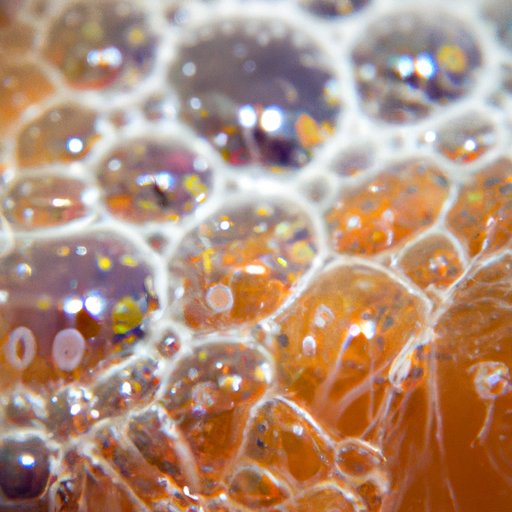
Introduction
Have you ever struggled to make the perfect bubbles? If so, you’re not alone. Many people encounter issues when trying to create bubbles that are big, sturdy, and long-lasting. That’s where we come in. This article aims to provide a step-by-step guide on how to make bubbles solution, covering everything from the science behind bubbles to alternative recipes to try. Our target audience is people who have encountered problems making bubbles solution and are looking for a comprehensive guide to help them succeed. Let’s get bubbling!
A Step-by-Step Guide
Making bubbles solution at home has many benefits, including cost savings and the ability to customize the recipe to meet your specific needs. To make bubbles solution, you will need:
- Water (distilled or purified for best results)
- Dish soap (regular strength)
- Corn syrup or glycerin (optional for added stability and longevity)
Mix the following ingredients together in a large bowl:
- 6 cups of water
- 1/2 cup of dish soap
- 1/2 cup of corn syrup or glycerin (optional)
Stir the ingredients gently to avoid creating suds. Let the solution sit for several hours or overnight. If too many suds form, remove them with a spoon or ladle. Once the solution has settled, it’s ready to use. Dip your bubble wand into the solution and blow gently to create beautiful bubbles!
Some tips and tricks for creating the best bubbles include:
- Dipping your wand into the solution slowly and at a slight angle
- Blowing gently and steadily
- Using a clean and dry wand for each new bubble
Common mistakes people make when making bubbles solution include:
- Using too much soap, which can cause the solution to be too soapy or not work at all
- Not letting the solution settle before using it, which can create excess suds and interfere with bubble formation
- Blowing too hard, which can cause the bubbles to pop quickly
To avoid these mistakes, make sure you follow the recipe carefully and take your time when creating your bubbles.
The Science behind Bubbles
Bubbles are fascinating examples of science in action. They are formed when air is trapped inside a thin film of liquid and creates a spherical shape. The properties of the solution and the wand used to create the bubbles are both important factors in bubble formation.
One of the key ingredients in bubbles solution is surfactants, which are molecules that help reduce the surface tension of the liquid and make it easier for air to be trapped inside. Dish soap is a popular surfactant used in bubble solutions due to its ability to lower surface tension effectively. Other factors that can influence bubble formation include temperature and humidity. For example, bubbles form best on a humid day because the water helps to stabilize the bubbles and prevent them from evaporating too quickly.
Homemade vs. Store-Bought Solutions
While making your own bubbles solution has many benefits, including customization and cost savings, store-bought options are also available for those who prefer convenience. Store-bought bubbles solution can vary in quality and ingredients, so it’s important to read the label carefully to ensure you know what you’re getting.
Some of the best store-bought bubbles solutions on the market include:
- Bubble Thing Big Bubble Mix (easy to make giant bubbles)
- Gazillion Bubbles Solution (long-lasting bubbles)
- Froggy’s Simply Sanitizer Bubble Juice (double-duty formula that cleans and creates bubbles)
While these options can be effective, they may not be as customizable as homemade options. Additionally, store-bought solutions can be more expensive in the long run, especially if you’re an avid bubble lover.
The History of Bubbles
Bubbles have a long and fascinating history. They have been enjoyed by people all over the world and have been used for many different purposes. For example, bubbles have been used in religious ceremonies, for entertainment purposes, and as a symbol of luxury.
The earliest known record of bubbles dates back to ancient times when they were used as part of religious ceremonies in several cultures, including Greece and Rome. Bubbles were also popular during the Renaissance era when wealthy individuals would pay for elaborate bubble shows. Today, bubbles are enjoyed by people of all ages and continue to be a popular part of entertainment and art.
Some cool things that can be done with bubbles include:
- Creating bubble art using colored solutions and different types of wands
- Experimenting with the shape of bubbles by using different types of instruments to create them (i.e. straws or loops of string)
- Making giant bubbles using large wands and specialized solutions
Alternative Recipes
If you’re looking for a unique and creative twist on bubbles solution, there are several alternative recipes to try. Some options include:
- Gelatin bubbles (using gelatin and water)
- Sugar bubbles (using sugar and water)
- Foam bubbles (using shaving cream and water)
It’s important to note that alternative bubbles solutions may require different types of wands and may be more delicate than traditional soap and water solutions. Additionally, some solutions may not be suitable for all ages or environments, so it’s important to do your research before experimenting with different recipes.
Conclusion
Congratulations, you’re a bubbles solution expert! By following our step-by-step guide and learning about the science behind bubbles, the history of bubbles, and alternative recipes to try, you’re well-equipped to create beautiful and long-lasting bubbles. Whether you choose to make your own homemade solution or try out a store-bought brand, we hope you have fun experimenting and exploring all the creative possibilities that bubbles have to offer.




